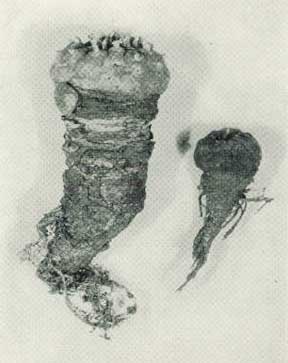Peyote and the American Indian, Page 3
By RICHARD EVANS SCHULTES
Then the mescal buttons are passed around, each participant taking four. More may be had at any time.
The singing is started by the leader. He sings four songs accompanied by a gourd-rattle, and a drum that another worshipper beats. The drum (a small iron pot covered with buckskin) is thumped rapidly so that the beats fuse into a, low hum. The musical instruments are handed around clockwise, each man singing four songs; then the circuit begins again: In the meantime, peyote is being eaten and prayers are being said.
The singing is interrupted for the Midnight and the Dawn Ceremonies when drinking-water is passed around. All paraphernalia are handed to the leader and placed at the altar, prayers are said, and the leader sings appropriate songs. In the Midnight Ceremony, he leaves the tipi, prays, and whistles four times in the four directions on an eagle wing-bone whistle. Doctoring may be done during the Dawn Ceremony; this ritual typically consists of administering peyote tea to the patient, sometimes blowing heat from a glowing ember of the altar fire over the ailing part, and praying, using the sign of the cross. Members are often brought to be treated.

THE PEYOTE IS MOSTLY ROOT
The ceremony ends at dawn with four "quitting songs" and prayers. The "Father Peyote" may be passed around to bless the group. A meal of corn, meat, fruit, bread, and water follows and after this, the group leaves the tipi, which is usually taken down at once. The rest of the day is spent lounging about, talking and singing; a feast is served by the host at noon.
Peyote serves the Indian not only as a medicine and as a religious sacrament, but its worship provides for religious and social, fellowship, an important function, as the older tribal ceremonies are dying out. In some tribes, the Bible is used, interpreted in terms of the peyote religion. Brotherly love is a teaching of the cult; acceptance of what is good in both cultures and reverence for Indian tradition are its most characteristic features. Many believe that the religion is a manifestation of resignation to encroaching white culture, and that the part that this small plant has had in helping to satisfy and reorient the Indian has not yet fully been realized.
Despite fierce opposition from missionary groups, the peyote cult, in Oklahoma, has been organized into a chartered sect-the Native American Church. The latest figures (1922) indicate that about 13,500 Indians participated in the peyote ceremony; the number, however, must be greater now.
In Mexico, the custom of gathering peyote in a forty day pilgrimage is an annual ceremony; the plant is sought by penitents, gathered ritually, and carried home to be used throughout the year. The Indians of Oklahoma follow this custom of going themselves to gather the plant, but automobiles and trailers are used, and few taboos surround the "pilgrimage".
Many tribes, far removed from the home of peyote, are supplied by merchants situated on the Rio Grande in Texas. A large trade has grown up in mescal buttons; the dried plants are sent by mail as far north as the Canadian border. A conservative estimate of per capita consumption of buttons would amount to about 500 annually. As the price of the buttons varies from $2.50 to $5.00 per thousand, it is evident that the peyote industry is a large one.
Of the many interesting chapters in human history that have centered around the uses of plants, none is more fascinating nor more historically momentous than the one dealing with this extraordinary cactus whose influence is felt far from its restricted native home. And the last pages of the peyote chapter are yet to be written.
 Printer-friendly version
Printer-friendly version
